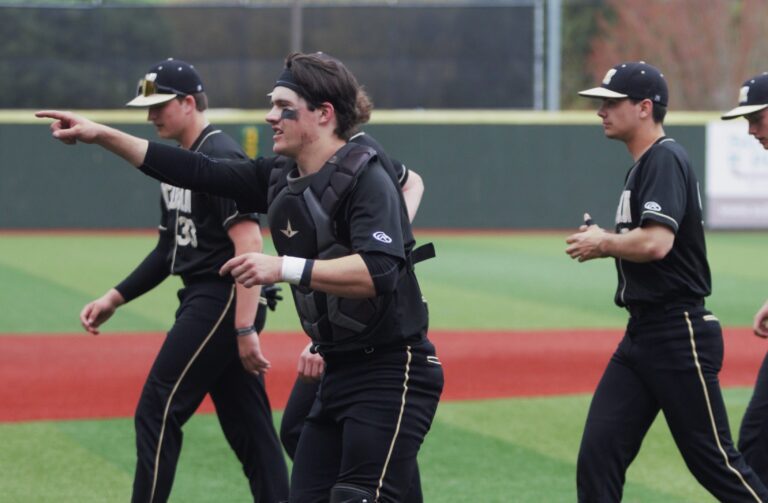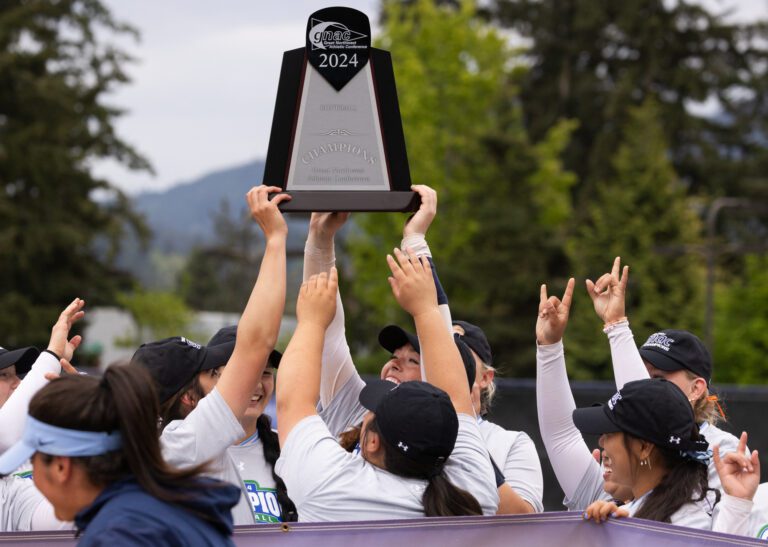Whereas most high schools don’t even have a dedicated strength and conditioning coach, Tyler Perry is pioneering the use of in-depth fitness technology in Nooksack Valley High School classrooms and with select athletic teams.
The freshmen in his class follow a finely tuned workout plan, can track minute improvements in their 10-meter sprint times and monitor intensity levels with an armband heart rate monitor, among other things, if they choose.

At the classroom level, the goal is to attract more kids to weight training and conditioning as a function of everyday health via visual, concrete metrics. With NV’s athletics teams, the goal is to have every possible edge over their opponents.
“Nothing I’m doing is groundbreaking,” Perry, 31, said. “I’m just the first one in this area.”
A ‘holistic approach’ to training
Perry mainly employs five separate devices to help track strength and conditioning metrics: A sprint velocity tracker (or distance timer, which can be converted to speed), heart rate monitor, vertical jump pad, GPS sensor, and barbell velocity tracker.
Each has its own unique use for all experience levels, whether the user is an elite athlete or a student in a weight training class who has never been in a weight room before enrolling.
Use of the tech is voluntary by each athlete or student.

Sprint velocity tracker: Measures time between cones, from the beginning of the sprint to the end via a Bluetooth device attached to the user. Can be converted into mph.
Heart rate monitor: Tracks current heart rate percentage relative to maximum heart rate. Allows users and coaches to emphasize certain exercises/drills based on high or low intensity.
Vertical jump pad: Digitally measures vertical jump using solely a pad on the floor.
GPS sensor: When outdoors, uses GPS data to track speed, specific movement trends, the exact path traveled during games and much more via a device attached to the athlete.
Barbell velocity tracker: Measures velocity of the barbell and power generated by the user when doing lifts such as deadlifts, squats, etc. while also providing cadence between repetitions.
Perry compiles metrics from some or all of the devices, depending on the athlete, into a Google spreadsheet, where he keeps individual profiles of their progress.
The students can view their results on one of the devices in Perry’s “army of iPads.” It allows them to visualize their improvement, beyond just how much weight is on a bar or how many reps they did.
“It levels the playing field among kids in the weight room,” Perry said. “There’s only so much excitement in watching a squat. There’s just so much more to athletics that’s enjoyable.”
Specifically in the case of the GPS sensor, Perry can meet with a soccer player, for example, and go over the entire path they traveled during a game — overlayed on the satellite image of the field — to recognize trends. As NV’s head track and field coach, Perry has also used it to measure the speed of relay hand-offs and how runners maintain their speed.

NV senior Devin Coppinger, who will play women’s basketball at the University of Washington next year, began training with Perry during her sophomore year to improve her agility and quickness.
The technology was confusing at first, she said, but rewarding once she understood how it all worked and what the metrics meant. Seeing a number and trying to beat it also tapped into her competitive side.
“It’s an easy way to check in and see how much progress you’re making, but also a way to keep it fun and competitive,” Coppinger said. “You’re literally, visually able to see the progress … [Perry] took all of that to the next level, and very professionally — like how a lot of college teams handle things.”
Perry’s most in-depth work with an NV athletics program — particularly with heart rate monitors — has been with the back-to-back 1A state champion girls basketball team, providing data to head coach Shane Wichers.
Perry recalled a game from the 2023–24 season when the team was incredibly inefficient shooting the ball. After the game, he analyzed the team’s heart rate data from the previous five days and didn’t see the typical differences between practices and a game. He recommended a lower-intensity practice, and the team performed better in its next contest.
“Most of the time, unless I see a trend, I go hands-off,” Perry said. “It’s a combination of everyone working together, doing their little part.”

But Perry, who is a certified strength and conditioning specialist, knows his methods will not make or break a program. It comes down to the athletes. Proper recovery is also vital, which is why he works closely with NV’s athletic trainer, Michael O’Bryan.
For any school trying to maximize the potential of their students’ athletic potential using methods similar to Perry’s, he recommends one comes with the other.
“We’re really trying to focus on having a holistic approach to training,” Perry added. “I’m not good enough to keep them healthy throughout the year. You have to have a professional in different areas … just make sure you’re doing it the right way.”
Coppinger said she feels the tools, and how Perry implemented them, truly pushed the girls basketball team to the next level.
“[Perry] was so dedicated to our team this [past] season and has a great deal to do with all the success we’ve seen in the past two years,” Coppinger said.
Where does the money come from?
Perry is allotted $5,000 annually by the district to use on strength and conditioning goals.
Around $1,500 immediately goes to TrainHeroic, a program to organize workouts, and the remainder for improvements or repairs to the high school’s weight room and tech upkeep or purchases.
Perry said he would like to get a few more GPS sensors to allow for a more complete look at outdoor sports teams. Another goal is eventually purchasing centralized software to house athlete profiles — rather than manually compiling them in Google Sheets.

The long-term plan is to get similar tech into the district’s three elementary schools and middle school, so students are knowledgeable and enthusiastic about the systems by the time they enter high school.
With the tech evolving, Perry believes students can benefit beyond just personal fitness goals.
“I’m able to give students the experience with this stuff that, when they step out into the job market, these are legitimate jobs,” Perry said. “[If] they want to be a trainer, if they want to get into data science — NFL teams, college teams are hiring people to do this stuff.”
Connor J. Benintendi is CDN’s sports editor; reach him at connorbenintendi@cascadiadaily.com; 360-922-3090 ext. 104.




